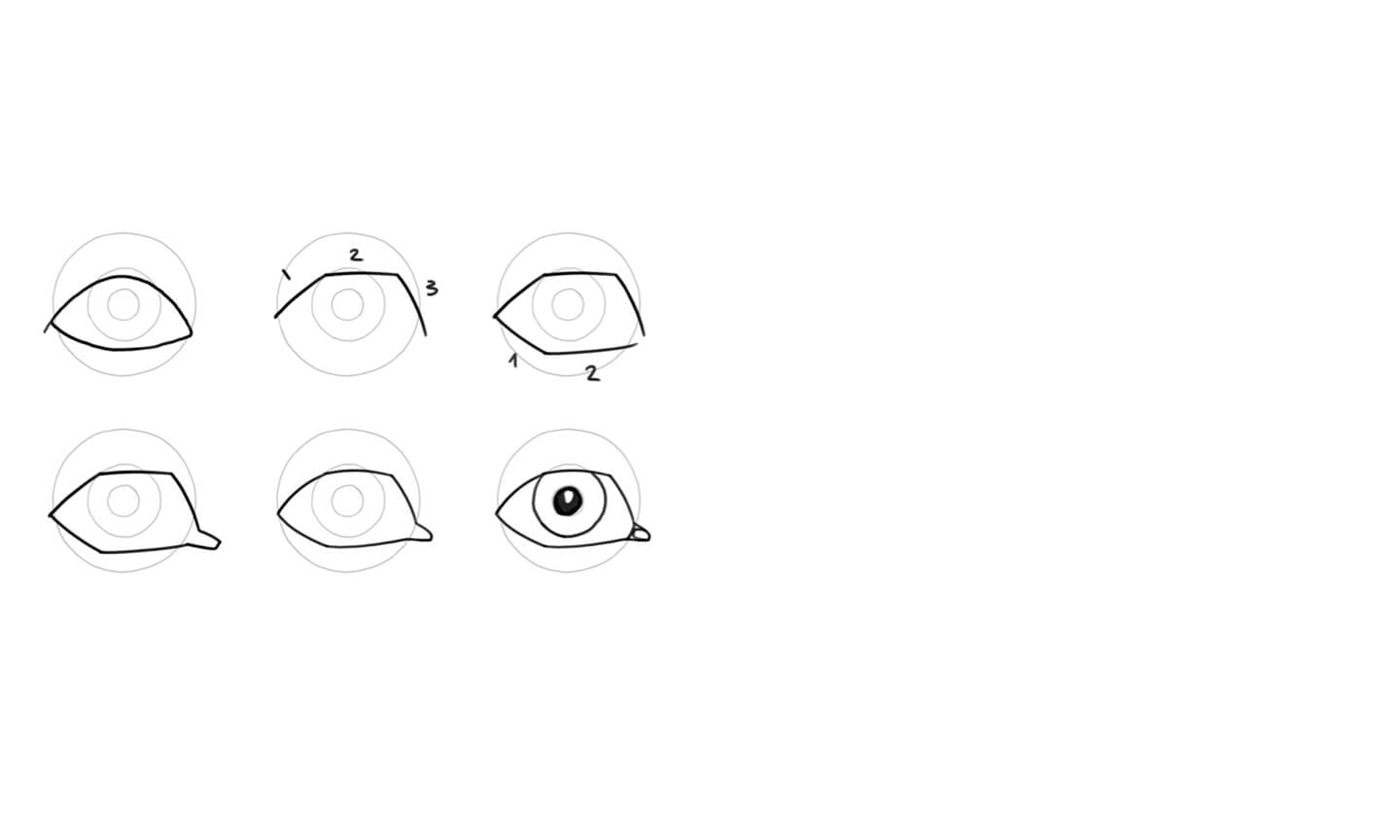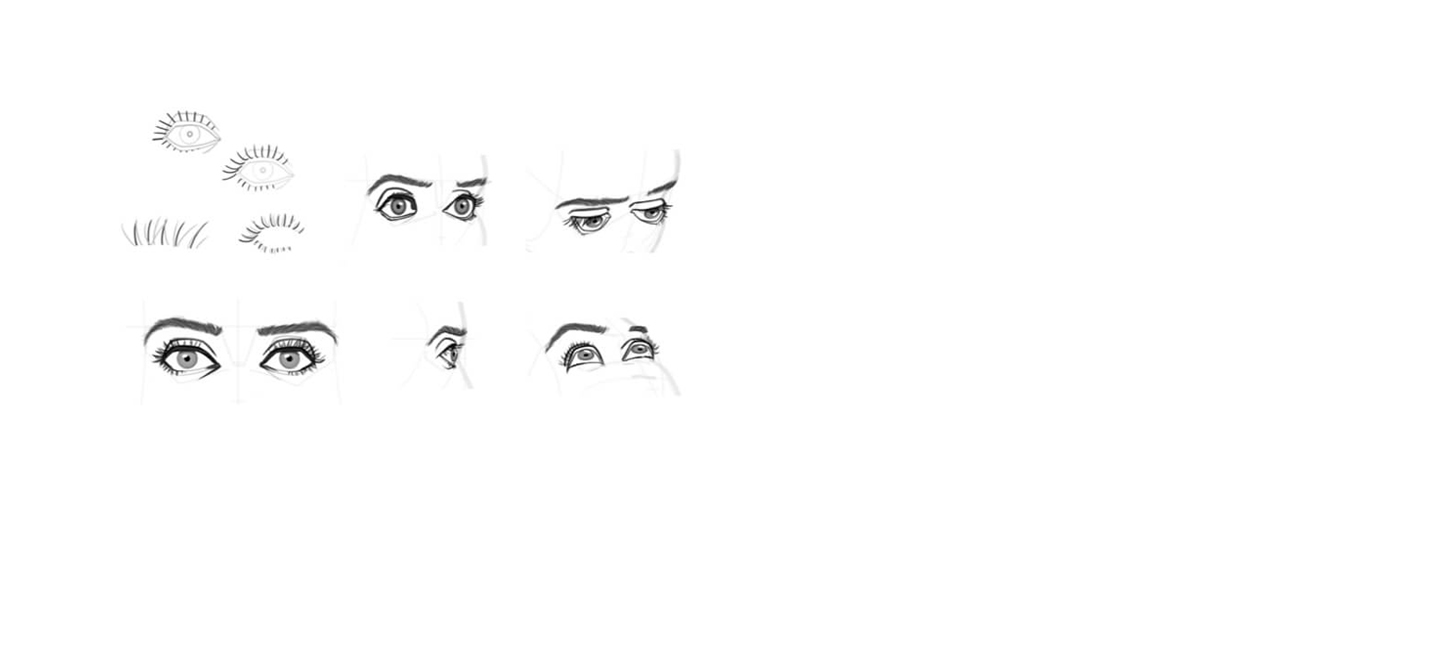


歡迎來到如何畫眼睛的教學。與平常一樣,並非只有一種方法才能畫出某種東西。不過,想要好好開發與改善自己的技術和方法,有些訣竅與技巧非常受用。我在這裡盡可能總結了許多技巧,我也會盡量用一種有趣的方式來說明。

之前曾經畫過臉的人,畫眼睛的時候,可能都是先畫上兩個點或幾個筆畫。歷經幾次嘗試後,大概就會變成兩個中間有圓點的圓圈。這種抽象的表現方式,實際上非常準確地總結了眼睛:兩顆球體,每顆球體都有個指示視線方向的瞳孔。下一步,我們這些大膽的插畫家會覺得,我們需要透過眼睛來表達情感。於是,我們在眼圈形狀中加上眼皮。我們很快就會發現,眼皮下垂往往看起來很生氣或邪惡,上翹的眼皮則通常看起來很悲傷或溫順。
這種基本的眼睛表現類型是卡通、漫畫和動畫的經典,這樣畫的理由很充分:這些卡通式的眼睛可以呈現出相當豐富的情感。如果我們仔細觀察就會發現,漫畫家其實對眼睛形狀做了很多思考,就算他們最後選擇乍看之下很簡單的表現形式。在探索接下來的步驟時,還請牢記這一點。

首先,我們試著瞭解一下眼睛的實際結構。暸解結構並不代表每幅畫都必須包含眼睛的所有細節。你得自己決定要強調哪些細節,要省略哪些方面。你的個人風格就是在這些選擇中發展出來。
但先回到眼睛的結構:
眾所周知,眼睛是個乒乓球大小的球體,位於頭部內。所以,先從畫出這個球體開始吧。透過畫出球體的水平和垂直軸,我們可以表明這不只是一個圓,而是一個 3D 球體,在這裡,球體稍微往左上方轉。畫這兩個軸的時候,確保是橢圓形的,而且正好位於圓的一半高度或一半寬度。

從正面看,虹膜大約是整個眼球的一半大小。瞳孔的大小則因人而異,也取決於光線和心情。此外,虹膜並不是平放在眼球上。反而是比較像隱形眼鏡。從正面畫眼睛的時候,我們不需要擔心這個細節。不過,眼睛轉動得愈遠,虹膜「凸起」就愈明顯。技術上來講,瞳孔其實不是一個黑點,而是一個小孔,光線穿過它進入眼球。瞳孔位於虹膜後方的中心,而不是在虹膜上。這就是為什麼一隻眼睛看向側邊時,我們的瞳孔會稍微往眼睛中心移動。
圖片顯示眼睛朝三個方向轉動。注意看虹膜和瞳孔的變化:

接下來,我們要來仔細研究藝術家心中所謂的「眼睛」到底是什麼形狀。我們所說的,其實是眼球一部分凸出的開口,或說上下眼皮邊緣之間的空間。基本上,我們眼皮邊緣的形狀像兩個扁平的 U 形,由內轉向彼此。我們更進一步來看一下這兩個 U。
就算是經驗豐富的繪圖師,在畫上眼皮的線條之前,也經常需要花點時間以專家的角度審視,在心裡做好規劃。這是因為,即便這條線出現了非常微小的偏差,也會整個改變臉部的表情。這個技巧會很有幫助:把上眼皮分成 3 個部分。(對了,這種把難畫的線條分成幾部分的技巧,不只適用於眼皮。任何線條都可以透過這種方式預先勾勒出來。)下眼皮也可以分成幾部分。
不過,這裡最好只畫兩筆,不要畫三筆。出於某種謎之原因,如果我們把上眼皮分成三部分,下眼皮分成兩部分,眼睛最後看起來會更有活力。某些藝術家會反向操作,上眼皮兩筆,下眼皮三筆。大家試試看。
在眼睛的中間部分,右邊這裡,你會看到所謂的淚腺。
這因人而異,有時甚至根本不存在。
現在我們已經先勾勒好眼睛的形狀,我們可以把細分線的角稍微修圓一點,或試著把兩條雙眼皮線畫得清楚些。

這個 5 線概念提供了很豐富的變化可能性。根據線條長度比例以及角度,可以創造出非常多種不同類型的眼睛,表達豐富的情緒。當然,這些線條主要用來事先勾勒,至於想在眼睛上繼續使用哪種風格,都以你為主。然而,運用 5 線概念,可以是非常有趣的風格手段。

接下來,我們應該牢記,兩個眼皮也有一定厚度。一方面,從側面看時,眼皮會因此比眼球突出一點;另一方面,一條狹窄的邊緣線始終可見,幾乎與我們之前的 5 條線平行。或許你會在某個時候想畫流淚中的眼睛,那你可能會想知道,淚水會集中在下眼皮的窄脊上。我們並非總是看得見這兩個區域,這取決於我們是從上方或下方觀察眼睛,以及眼睛在做什麼。

眼睛,包括眼皮,可以透過這種方式,從每個想像得到的角度建構出來。從球體開始,然後想像眼皮包覆著球體。使用 5 條線來勾勒基本形狀。你需要根據視角來調整 5 條線的長度與角度。某些視角,你可能只需要 2 或 3 條線,因為其餘的部分都隱藏在眼球後方(例如剖面圖)。哪些時候會看得見眼皮的狹窄區域呢?哪些線條是你想要強調的,哪些是你可以省略的?接下來我們會把眼睛放在臉上,然後再繼續詳細探討這個問題。

既然我們已經瞭解眼睛的各種資訊,現在我們試著把眼睛放到不同的頭型吧。如果你已經可以從不同角度畫出頭型,那很棒!如果還沒辦法,那我強烈推薦前一篇「如何繪製人類頭型」的教學。我會使用跟那個教學一樣的頭型。這些頭型會是非常方便的出發點,但並不一定需要。
為了界定眼部區域,我喜歡從鼻子上方幾乎呈三角形的小區域開始。各位可以看到,從頭頂往下看時,三角形會變短,但向上看時會變長。在剖面圖,從側面看,三角形變成了一條線。
對了,如果你想把三角形畫到頭型上,你可以使用頭型中心線上的參考線來輕鬆定位。

接下來,非常簡單,我們要界定眼睛周圍骨骼的形狀,因為這些骨頭很重要。在我們被揍或是被足球砸到時,這些骨頭會保護我們眼睛。;) 要界定眼睛周圍的骨骼,最簡單的方法是使用蝙蝠俠面具。這時我們的三角形就是出發點。
如同我們的眼皮結構,蝙蝠俠面具由頂部 3 條線和底部 2 條線組成。每個外緣都與我們頭型的切口區域吻合。如果把蝙蝠俠面具放到傾斜的頭,注意看角度會發生什麼變化,同時注意哪些線條看起來變短了。當然,在剖面圖,我們只能看到面具的一部分。

很顯然,眼球並非黏在臉的正面。與此相反,眼球位於我們頭部頗深的位置。所以,在把球體放到蝙蝠俠面具時,我們必須稍微偏移眼球的位置。偏移多大取決於視角。頭部朝上傾斜時,我們可以特別清楚注意到這一點。在剖面圖中,很容易就能看到這一點。從正面看,眼球的深度乍看並不明顯。
兩個眼球必須相距多遠,並沒有一定的規定。但如果你不確定,就想想兩顆眼球之間還有第三顆(或更多顆)球體。這樣你就會獲得一個很適當的距離。

千萬別低估之前有關瞳孔和虹膜內容的重要性。就算只是虹膜中的微小凸起,也能增強眼睛的真實感。當然,如果是從正面看,你無需再修飾了。但是,只要眼睛沒有直視觀看者,別忘了為虹膜和加深的瞳孔加上弧度。

現在,我們來談談眼皮吧。首先,利用頭型引導線,標出眼睛兩個外緣各自的位置。然後,畫成五邊形。如果你已經乾淨俐落地建構出球體,那麼其他部分就會簡單許多。這裡也一樣,可以根據你觀看頭型的角度,對兩側角度與長度進行細微的調整。如果視角推到極致,五邊形也可能形成內角,比如圖中這兩個分別向上和向下看的頭。而在剖面圖中,虹膜會覆蓋住一半的五邊形。

如果想強調你決定用來描繪臉部的視角,那麼第二條眼瞼線是個好方法。仔細注意狹長的眼皮表面有哪些部分面向觀看者。這些部分會比其他部分厚。例如,抬頭時,只能看到上眼皮。但如果頭轉向一側,在每隻眼睛周圍,眼皮表面的不同區域都會變得清晰可見。

兩條眼皮褶痕是眼皮與臉部之間的分界線。尤其是上眼皮褶痕,能讓眼睛增加深度。這邊你可以使用球體作為引導。此外,這裡也值得我們堅持去進行眼皮設計的細化。如果不想讓臉看起來老邁或疲倦,記得把下眼皮褶痕畫得比上眼皮褶痕稍微柔軟、稍微短一點。甚至可以稍微暗示一下就好。

眉毛通常可以很清楚地表達臉上的情緒。在中立、不動的狀態,眉毛會從三角形的頂部開始,先略微上升,然後再次變細。眉緣也一樣,會與原始頭型設計的切口區域相吻合。
先用輪廓來確定眉毛形狀是最佳做法。如此做可以簡化後面的步驟。此外,你也可以在眉形內,利用細線條表示毛髮生長的方向。從中間開始,先使用陡峭的線條,接著在靠近邊緣處將線條拉平。

現在,我們總算可以享受付出後的甜美果實。從這裡開始,你必須加入自己的風格。所有的繪圖師都有自己獨特的線條和筆觸。或許你是比較愛素描風的人,或想立刻開始處理表面或色彩。毫無疑問,這完全由你來決定。從現在起,你會有大量機會來發展你的畫作。不過,由於我們不打算在本教學裡討論不同風格或顏色,所以我們先用全然乾淨的線條來畫我們的眼睛吧。
如各位所見,兩條上眼皮線也可以結合成一條粗線條。如果想創造陰影,更是要這樣做。處理下眼皮時,最好少用一些輪廓線,因為如果光源來自上方,這裡通常不會出現陰影。

如果是使用繪圖用數位板繪製虹膜和瞳孔,我要給你一個簡單(但非常實用)的解決方案:將筆刷的不透明度降到 30% 左右,以便繪製虹膜。如果你使用的筆刷比虹膜本身略微小一點,那會更容易。接下來,我們透過減少筆刷尺寸與硬度,為虹膜加些光澤,利用白色令虹膜中心變亮。現在你可以將瞳孔塗成黑色。當然,請記得將瞳孔稍微偏離虹膜中心,具體視你的視角而定。現在可以再次利用白色來放置光反射點。最好是稍微偏離瞳孔。光反射點不一定是一個點。你可以嘗試看看不同的形狀。為虹膜加上最後的修飾,在上眼瞼表現出眼皮投射到虹膜的陰影。如果喜歡,你也可以畫出瞳孔到虹膜邊緣巧妙交替的黑白線條(最好畫在另一個單獨圖層),為虹膜結構多添一些細節。不過,給個小建議,只有你畫的眼睛確實大到會讓人注意這個細節,再花這個心力吧。

眉毛的形狀很容易能從看上去是畫的,變成看起來像真眉毛。你可以使用「塗抹」工具來做到這一點。為了呈現這種效果,擦拭時請務必沿著毛髮生長的方向,這樣形狀的硬邊就會變成一條輕盈的鋸齒狀線條。小心別讓這些鋸齒狀太均勻或太亂。對結果滿意後,稍微把鋸齒線條弄淡些,然後加一些毛髮來完成眉毛。介於整齊與混亂之間的細線,同樣適用於眉毛毛髮。畫出單獨的毛髮時,筆觸要盡量快。最好使用略為彎曲的線條,線條要逐漸變細而且方向不要老是一樣,但同時依然要注意毛髮的生長方向。

這是最後一個但同樣重要的步驟,這裡有個小挑戰。睫毛通常要多嘗試幾次,做一點練習。一些小訣竅或許會讓這個任務簡單些:睫毛長在第二條或說外眼瞼線上。眼睛外緣的睫毛通常比較長。下睫毛比上睫毛短,接近中間時,通常變得很細,幾乎看不見。此外,眼睫毛永遠是彎的。彎曲的方向取決於你對眼睛曲率的看法。意思是,曲線往眼睛中心逐漸減小,而睫毛在眼睛兩側往反方向彎曲。這聽起來可能頗複雜,但其實看圖很容易理解。
畫睫毛時,運用兩步驟流程會很有幫助:首先,每個眼皮只畫大約十根睫毛。特別注意所有睫毛都要以正確的角度彎曲。同時,注意長度,讓睫毛像眉毛一樣逐漸變細。第二步,在原始睫毛間的空隙插入「混亂的睫毛」,這裡用灰色顯示。稍微改變曲線的長度和方向,偶爾讓幾根睫毛聚在一起,形成一小群。
根據轉頭的方式,睫毛的方向也會改變。這可能需要稍微做一下空間思考。慢慢來。仔細想一想睫毛要指向哪個位置。

十分具有挑戰性的教學就到這裡結束。你不用馬上消化並運用我們今天教的所有內容。但是,在本教學中,你幾乎可以找到所有繪製眼睛所需的訣竅。你絕對會拿起一兩個來試!
祝你畫得開心,下次教學再見!
劇透警告:我們剛才煞費苦心勾勒出來的眼睛,會在下一個教學中直接消失在鼻子後面。
得益於 13.3 吋螢幕自然的表面摩擦和極低的反光,Wacom One 能創造出熟悉的、紙筆般真實的書寫體驗。數位筆手感輕盈自然,其可在你選擇的軟體中化身為鉛筆、筆刷或粉筆,為你提供繪製寫實眼睛所需的一切。裝置隨附創作用軟體,並可將其連接至你的電腦以及特定 Android 裝置。

Wacom One 13 手寫液晶顯示器
以精準的數位筆在高解析度螢幕上進行直覺式繪圖、設計和創作。
透過自然的介面技術讓人與科技緊密相依,是 Wacom 一貫的願景。這項願景讓 Wacom 成長為全球的互動式數位板、手寫液晶顯示器及數位筆的龍頭製造商,更是數位簽章保存與處理解決方案供應商。Wacom 直覺式輸入裝置的先進技術,已在全球各地造就出許多一流數位藝術、電影、特效、時尚及設計鉅作,其領先的介面技術同時為商業和家庭用戶提供表達自我個性的利器。創立於 1983 年的 Wacom 是全球性企業,總部位於日本(東京證券交易所股號:6727),分公司及行銷與銷售代表處遍佈世界各地 150 多個國家。